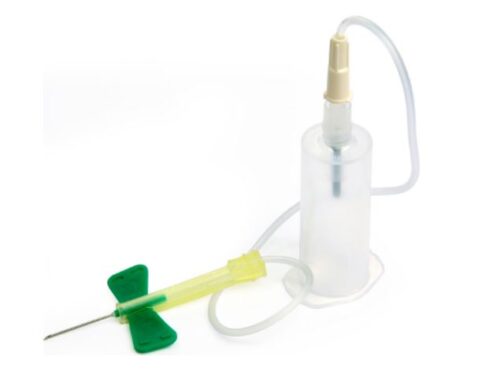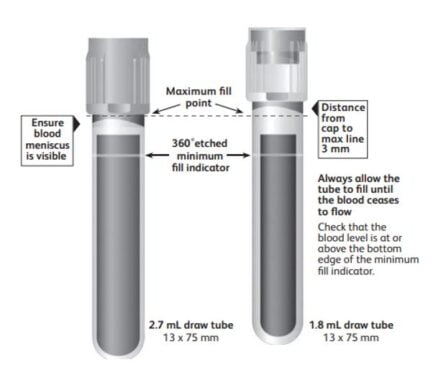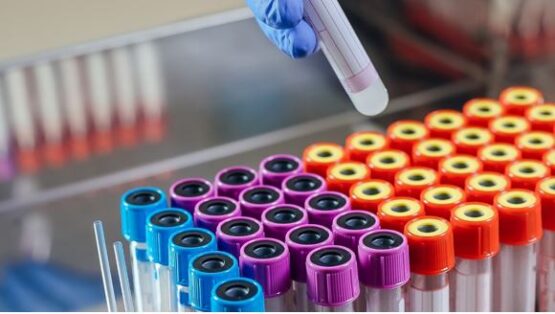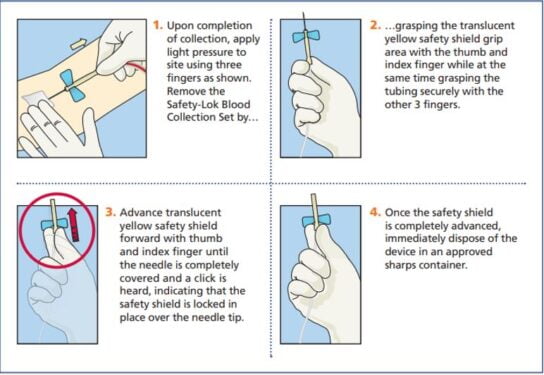In hospitalized as well as in outpatients, taking blood samples in order to run tests is a frequent practice. Although the methods to draw blood are well-developed, the problem arises when multiple blood samples are to be collected. A simple yet useful device that can be employed to solve this problem is the vacutainer blood collection system.
The vacutainer blood collection system comprises a sterile container in which a vacuum is generated. This allows the technician to draw multiple blood samples at a single time. In this way, multiple sampling can be done with a single needle puncture thus making the process convenient and less painful for the patients as well.

Vacutainer blood collection set
Components of vacutainer blood collection system
The vacutainer blood collection set consists of a needle that has the job to prick the blood vessel under the skin with the aim to make a way for the blood to pass into the container. The needle is immediately followed by a holder which contains the blood sample. A rubber sleeve keeps the needle in its place. The holder is further connected to a tube which is responsible for creating a vacuum in the holder.

2 3
Components of a vacutainer blood collection set

A needle attached to a vacutainer blood collection set
Types of vacutainer blood sampling tubes
Vacutainers blood collection tubes are sterile sample collection tubes that are made up of glass as well as polyethylene terephthalate (PET) or polypropylene plastic. These tubes are color-coded (only stoppers are colored) to differentiate between their types as the tubes are coated with certain materials called additives to aid the process of blood collection. Thus the technician has a choice to select from a wide range of vacutainers the most suitable one for the test to be performed.

Vacutainer blood collection tubes
| Color codes | Additives | Tests |
| Light blue stopper | Sodium citrate | Coagulation studies, D-Dimer, INR |
| Red stopper | No additive | Viral serology, endocrinology, vitamin D |
| Gold stopper | Clot activator and gel | Hepatitis, CMP, LFT, BMP, U&E |
| Dark green stopper | Sodium heparin | HLA typing, insulin, ammonia |
| Purple stopper | EDTA | FBC, ESR, PTH, HBa1C |
| Pint stopper | EDTA | Blood cross match, direct antiglobulin |
| Royal blue stopper | EDTA | Heavy metals testing, toxicity |
| Gray stopper | Sodium fluoride | Glucose, lactate |
| Yellow stopper | Acid citrate dextrose A | HIV testing, tissue typing |
| White stopper | EDTA | PCR+G12:120 |

Color-coded vacutainer blood collection tubes
How to use a vacutainer blood collection set?
The vacutainer collection set has to be used in accordance with the standardized guidelines of the ‘order of draw’ i.e. the steps to be followed to draw blood using the vacutainer set. This is advantageous in order to avoid inter-sample contamination. The needle can be put in place by one-handed or two-handed technique.

The one-handed technique of vacutainer set activation

The two-handed technique of vacutainer set activation
Applications of vacutainer blood collection set
The vacutainer blood collection tubes are suitable for the collection of not only blood but also plasma and serum samples. Their sterility makes sure not to contaminate the sample with microorganisms. Moreover, the glass or plastic material used as a tube material is safer and does not react with the sample.
Advantages of using vacutainer blood collection set
The vacutainer blood collection sets have the following advantages:
- The vacutainer set is easy to use.
- The process to draw blood using the vacutainer set is simple and quick.
- The risk of hemolysis i.e. the destruction of red blood corpuscles is minimum.
Disadvantages of using vacutainer blood collection set
The Vacutainer blood collection set is a simple medical device with vast applications in blood, plasma, or serum collection. However, it comes with a few disadvantages as well which are as follows:
- While drawing multiple samples at a time, the chances of contamination exist while changing the collection tube. In this case, the additives of the tubes get mixed up thus contaminating the blood, plasma, or serum.
- Another issue with the use of vacutainer blood collection tubes is the absence of any flashback to indicate the location of the blood vessel. Therefore, chances exist that the needle is not in the vein and the phlebotomist tries to draw the blood. In such a situation, no blood will be collected into the collection tube and the needle, as well as the tube, is to be discarded.
Precautionary measures
The following precautionary measures should be adopted while using the vacutainer blood collection set:
- The needle should be handled with care. It should be made sure that it is sterile before injecting it into the patient’s venous system. Moreover, the needle must be administered in a way that the chances of pain and bruises are minimum.
- It must be ensured that the needle is rightly placed into the vein. Otherwise, it may harm the neighboring tissues.
- Vacutainer tubes made up of glass are not suitable for sampling for immunohematology testing.
Conclusion
In medical setups, it is a daily practice to draw blood samples in order to test the patients for various possible diseases as well as infections. For this purpose, many devices are being used among which is the vacutainer blood collection system. This vacutainer blood collection set is an easy-to-use, inexpensive, and safer device which helps the phlebotomist draw a blood sample from the patient with ease without harming the patient. The device is patient-friendly as multiple samples can be drawn by a single prick. Thus the vacutainer blood collection system is a reliable, safe, and quick-to-use device.

PhD Scholar (Pharmaceutics), MPhil (Pharmaceutics), Pharm D, B. Sc.
Uzma Zafar is a dedicated and highly motivated pharmaceutical professional currently pursuing her PhD in Pharmaceutics at the Punjab University College of Pharmacy, University of the Punjab. With a comprehensive academic and research background, Uzma has consistently excelled in her studies, securing first division throughout her educational journey.
Uzma’s passion for the pharmaceutical field is evident from her active engagement during her Doctor of Pharmacy (Pharm.D) program, where she not only mastered industrial techniques and clinical case studies but also delved into marketing strategies and management skills.
Throughout her career, Uzma has actively contributed to the pharmaceutical sciences, with specific research on suspension formulation and Hepatitis C risk factors and side effects. Additionally, Uzma has lent her expertise to review and fact-check articles for the Health Supply 770 blog, ensuring the accuracy and reliability of the information presented.
As she continues her PhD, expected to complete in 2025, Uzma is eager to contribute further to the field by combining her deep knowledge of pharmaceutics with real-world applications to meet global professional standards and challenges.








